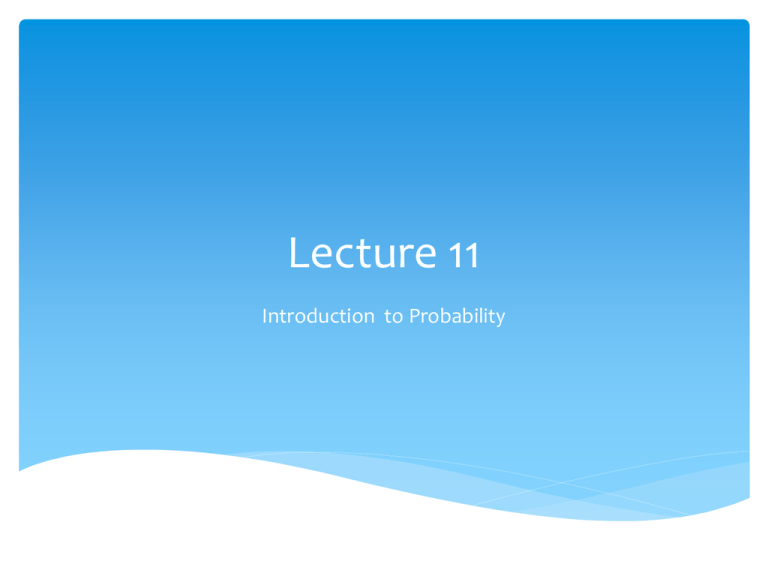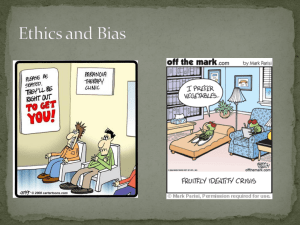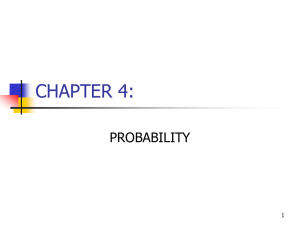Lecture 11-August 11 - i
advertisement

Lecture 11
Introduction to Probability
Which one would you be most likely
to play
Consider the following three games. Which one would you be most
likely to play? Which one would you be least likely to play? Explain your
answer mathematically.
1.
Game I: You toss a fair coin once. If a head appears you receive $3,
but if a tail appears you have to pay $1.
2. Game II: You buy a single ticket for $10 for a raffle that has a total of
500 tickets. Two tickets are chosen without replacement from the
500. The holder of the first ticket selected receives $300, and the
holder of the second ticket selected receives $150.
3. Game III: You toss a fair coin once. If a head appears you receive
$1,000,002, but if a tail appears you have to pay $1,000,000
11.1 Experiment, Outcomes, and
Sample Space
Experiment
- Is a process that, when performed, results in one and
only one of many observations.
Outcomes
- These observations are called the outcomes of the
experiment
Sample Space
- The collection of all outcomes for an experiment is
called a sample space denoted by S
11.1 Experiment, Outcomes, and
Sample Space
Example 11.1.1
Experiment
Outcomes
Toss a coin once
H, T
Roll a dice once
Toss a coin twice
Play Lottery
Take a test
Sample Space
Tree diagram
In a tree diagram, each outcome is represented by a
branch of the tree.
Example 11.1.2
Draw the tree diagram for the experiment of tossing
a coin twice.
11.1.1 Simple and Compound Events
Simple event
An event that includes one and only one of the
outcomes for an experiment is called a simple event
Compound event
A compound event is a collection of more than one
outcome for an experiment. Compound events
11.1.1 Simple and Compound Events
Example 11.1.3
In a group of people, some are in favor of genetic
engineering and others are against it. Two persons are
selected at random from this group and asked whether
they are in favor of or against genetic engineering. How
many distinct outcomes are possible? List all the outcomes
included in each of the following events and mention
whether they are simple or compound events.
Both persons are in favor of genetic engineering.
At most one person is against genetic engineering.
Exactly one person is in favor of genetic engineering.
11.2 Calculating Probability
Probability is a numerical measure if the likelihood
that a specific event will occur, is denoted by P.
the probability that a compound event A will occur is
denoted by 𝑃(𝐴).
Two Properties of Probability
0 ≤ 𝑃(𝑥) ≤ 1
𝑃(𝑥) = 1
11.2.1 Three Conceptual Approached
to Probability
Classical probability
Relative frequency concept of probability
Subjective probability concept.
Classical Probability
Classical Probability
The classical probability rule is applied to compute the
probabilities of events for an experiment for which all outcomes
are equally likely.
Example 4.2.1
Find the probability of obtaining a head and the probability
obtaining a tail for tossing a coin once.
Example 4.2.2
Find the probability of obtaining an even numbers for rolling a
dice once.
Relative Frequency Concept of
Probability
The relative frequency probability rule is applied to
compute the probabilities of events for an
experiment for which the various outcomes for the
corresponding experiments are not equally likely.
If an experiment is repeated n times and an event A is
observed f times, then, according to the relative
frequency concept of probability:
𝑓
𝑃 𝐴 =
𝑛
Relative Frequency Concept of
Probability
Example 11.2.3
Ten of the 500 randomly selected cars manufactured
at a certain auto factory are found to be
malfunctioning. Assuming that the lemons are
manufactured randomly, what is the probability that
the next car manufactured at this auto factory is
malfunctioning?
Subjective Probability
Subjective probability is the probability assigned to an
event influenced by the biases on subjective
judgment, experience, information and belief.
11.3 Marginal and Conditional
Probabilities
Marginal Probability
Marginal probability is the probability of a single
event without consideration of any other event. They
are calculated by dividing the corresponding row
margins (total of the rows) or column margins (total
of the columns) by the grand total.
Marginal Probability
In Favor
Against
Male
15
45
Female
4
356
Example 11.3.1
𝑃 𝑀𝑎𝑙𝑒 =
𝑁𝑜 𝑜𝑓 𝑚𝑎𝑙𝑒𝑠
𝑇𝑜𝑡𝑎𝑙 𝑛𝑜 𝑜𝑓 𝑒𝑚𝑝𝑙𝑜𝑦𝑒𝑒𝑠
𝑃 𝐹𝑒𝑚𝑎𝑙𝑒 =
𝑃 𝐼𝑛 𝐹𝑎𝑣𝑜𝑟 =
𝑃 𝐴𝑔𝑎𝑖𝑛𝑠𝑡 =
=
60
420
=
Conditional Probability
Conditional probability is the probability that an event
will occur given that another event has already
occurred. If A and B are two events, then the
conditional probability of A given B is denoted as
𝑃(𝐴 ∩ 𝐵)
𝑃 𝐴 𝐵 =
𝑃(𝐵)
Conditional Probability
In Favor
Against
Male
15
45
Female
4
356
Example 11.3.2
Refer to Table 4.2, find:
𝑃(𝐼𝑛 𝐹𝑎𝑣𝑜𝑟 𝑀𝑎𝑙𝑒)
𝑃(𝐼𝑛 𝐹𝑎𝑣𝑜𝑟 𝐹𝑒𝑚𝑎𝑙𝑒)
𝑃(𝐴𝑔𝑎𝑖𝑛𝑠𝑡 𝑀𝑎𝑙𝑒)
𝑃(𝐴𝑔𝑎𝑖𝑛𝑠𝑡 𝐹𝑒𝑚𝑎𝑙𝑒)
11.4 Intersection of Events and the
Multiplication Rule
11.4.1 Intersection of Events
The intersection of two events is given by the
outcomes that are common to both events. The
intersection of events A and B is also denoted by
either 𝐴 ∩ 𝐵 or 𝐵 ∩ 𝐴.
11.5 Union of Events and the Addition
Rule
11.6.1 Union of Events
The union of two events, A and B includes all
outcomes that are either in A or in B or in both A and
B. The union of events A and B is also denoted by 𝐴 ∪
𝐵.
𝑃 𝐴 ∪ 𝐵 = 𝑃 𝐴 + 𝑃 𝐵 − 𝑃(𝐴 ∩ 𝐵)
11.5.1 Union of Events
Example 11.5.1
A university president has proposed that all students
must take a course in ethics as a requirement for
graduation. Three hundred faculty members and
students from this university were asked about their
opinion on this issue. The table below gives a twoway classification of the responses of these faculty
members and students.
11.5.1 Union of Events
Find the probability that one person selected at
random from these 300 persons is a faculty member
or is in favor of this proposal? Is a student or is
opposed of this proposal? Is a student or is neutral of
this proposal?
Favor
Oppose
Neutral
Faculty
45
15
10
Student
90
110
30
Intersection and Union
Example 11.5.2
In a group of 2500 persons, 1400 are female, 600 are
vegetarian and 400 are female and vegetarian. What
is the probability that a randomly selected person
from this group is a male or vegetarian?
11.6 Complementary Events
The complement of event A, denoted by 𝐴 and read
as “A bar” or “A complement”, is the event that
includes all the outcomes for an experiment that are
not in A.
𝑃 𝐴 +𝑃 𝐴 =1
11.6 Complementary Events
Example 11.6.1
In a group of 2000 taxpayers, 400 have been audited
by IRS at least once. If one taxpayer is randomly
selected from this group, what are the two
complementary events of this experiment, and what
are their probabilities?
11.7 Mutually Exclusive Events
Events that cannot occur together are said to be
mutually exclusive events. Such events do not have
any common outcomes.
𝑃 𝐴∩𝐵 =0
𝑃 𝐴 ∪ 𝐵 = 𝑃 𝐴 + 𝑃(𝐵)
11.7 Mutually Exclusive Events
Example 11.7.1
Consider the following events for rolling a dice once.
A = an even number is observed = {2, 4, 6}
B = an odd number is observed = {1, 3, 5}
C = a number less than 5 is observed = {1, 2, 3, 4}
Are events A and B mutually exclusive? Are events A
and C mutually exclusive?
11.8 Independent and Dependent
Events
Two events are said to be independent if the
occurrence of one does not affect the probability of
the occurrence of the other. In other words, A and B
are independent events if
𝑃 𝐴 ∩ 𝐵 = 𝑃 𝐴 𝑃(𝐵)
𝑃 𝐴 𝐵 = 𝑃 𝐴 𝑜𝑟 𝑃 𝐵 𝐴 = 𝑃(𝐵)
11.8 Independent and Dependent
Events
A and B are dependent events if
𝑃 𝐴 ∩ 𝐵 = 𝑃 𝐴 𝑃(𝐵 𝐴)
𝑃 𝐴 ∩ 𝐵 = 𝑃 𝐵 𝑃(𝐴 𝐵)
11.8 Independent and Dependent
Events
Example 11.8.1
A box contains a total of 100 CDs that were
manufactured on two machines. Of them, 60 were
manufactured on Machine I. Of the total CDs, 15 are
defective. Of the 60 CDs that were manufactured on
Machine I, 9 are defective. Let D be the event that a
randomly selected CD is defective, and let A be the
event that a randomly selected CD was manufactured
on Machine I. Are events A and D independent?
Bayes’ Theorem
In a population of 100,000 citizen, 0.2% having a kind
of disease. If a test is conducted, the test is 99%
accurate to detect the disease.
Suppose you did a test and the result is positive. What
is the probability that the you do not have the
disease?
Bayes’ Theorem
If {A1, A2, …, An} is a partition of a sample space S, and
B is any event, then for each i = 1, 2, …, n we have that
𝑃 𝐴𝑖 𝐵 =
𝑃
𝐵 𝐴1
RMIT University; Taylor's College
.𝑃 𝐴1 +𝑃
𝐵 𝐴𝑖 .𝑃(𝐴𝑖 )
𝐵 𝐴2 .𝑃 𝐴2 +⋯+𝑃 𝐵 𝐴𝑛
𝑃
32
.𝑃(𝐴𝑛 )
Bayes’ Theorem
According to American Lung Association, 7.0% of the
population has a lung disease. Of those having lung
disease, 90.0% are smokers, of those not having lung
disease, 25.3% are smokers. Determine the probability
that a randomly selected smoker has lung disease.
RMIT University; Taylor's College
33










